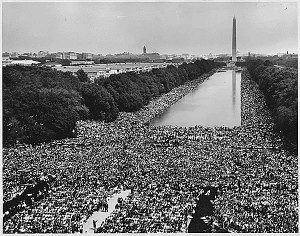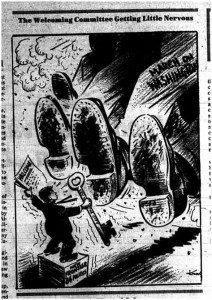“The Spirit of Good Will”
This is the seventh in a series of articles focusing on the momentous local changes and events in the civil rights struggle, fifty years ago in Orlando, by Doug Head, former Orange County Democratic Party Chair.

By late August 1963, the national movement toward civil rights was competing with anti-communist fear for the attention of the American people. In Orlando, it got the silent treatment. Though the March on Washington for Jobs and Freedom was just days away, the arrangements were not much covered in the local news.
On August 16th, the Sentinel reported (in a little article on page 3) that 1000 Floridians were expecting to assemble in Jacksonville and that Mable Richardson of Orlando was to coordinate local travelers for the NAACP. The same day’s paper featured a larger article “Negros Help Themselves” about the work of the Negro Chamber of Commerce’ Annual Directory, “a splendid catalogue of progress” …”and a creation of a Christian-like atmosphere,” which illustrated “the spirit of good will existing between Negro and white citizens.” That day’s paper illustrated the denial afflicting Orlando in other ways. Promoting Florida tourism in London, Governor Bryant was reported saying “we in Florida have no problem of integration because the laws of our state ban discrimination…and we haven’t had one single incident of violence.” The same day’s paper also reported that there were just four Negro doctors in the city and that the P. Philips hospital for Negros “near the vast high-grade subdivision for Negro citizens” needed more funds or it would close.
The rest of the week before the march, civil rights reporting was limited to national news and that was covered minimally. It was as if the March was not really coming. On the 18th Goldwater was leading Kennedy among southern voters, who were “Going solidly Republican” because they “were highly critical of the [Kennedy] Administration’s civil rights program” leading to “racial unrest.” On the 19th, there was reporting of the Southern Governors hearing a proposal from Mississippi that Negros be “relocated” to other states away from the South and a headline, “March Violence Feared.” On the 22nd, the Sentinel did re-print a story that Europeans were lining up at embassies to sign petitions of support for the March. The “Negro Edition” of 26th August, two days before the march, featured a full-page headline touting a Black Beauty Pageant on Labor day in Daytona at the Negro “Cypress Street Center.” And the Sentinel began a week-long series of commissioned articles by reactionary Victor Lasky about how bad President Kennedy had been in his rise to power.
On the 26th, the City Council postponed a vote on funding for urban renewal in the Holden-Parramore (but got a conflict disclosure from a councilman who owned land there) and received the thanks of West Church Street merchants for extra patrols to “keep down incipient trouble,” (white drive-by shootings or Negro demonstrators is unclear). They also appropriated funds for widening Colonial drive to four lanes East of Bumby and called for bids to finally light the Jones High Athletic field.
But the conservative Sentinel was clearly afraid of the March. It ran an editorial cartoon of huge Marching feet bearing down on Washington as Kennedy quivered on his political soap box.
On the 27th, the Sentinel finally reported (citing Ms. Richardson of the NAACP) that 22 Negros from the area would join the March and leave from the train station at 1:50 PM that day. They were advised to wear hats and sun-glasses. And that was it. No other reports preceded the March in the local paper.

On the 28th, as the March convened in Washington, the Sentinel headlined, “Explosions Mark School Mix.” It cited violence in Louisiana and South Carolina. More significantly, the Sentinel featured an ominous editorial with a small illustration of a Communist headed to the March with a brick in hand. It cited Strom Thurmond stating that “known Communists and Communist-front groups have declared themselves in and will have plenty of people in Washington today.” Predicting riots, the Sentinel said, “if the Reds are successful, you can bet this will happen. If it does not, we can thank the FBI.”
One voice of reason in the Sentinel was printed locally. The national columnist James Reston noted that the marchers were annoying official Washington with their petition to redress their grievance. He concluded, “the American Negro has obviously decided that he has to annoy the white man to wake him up.”
On the 29th of August, the day after the March, the Banner Headline of the Sentinel was not about the historic event, but about the signing of railroad strike legislation nobody remembers. An aerial picture of the crowd at the Lincoln Memorial ran on the front page, but with a smaller headline, “200,000 Join March” and an AP story which pointed out that there had been no arrests of marchers though 1700 had suffered from the heat and sun. Efforts by Nazis to break up the event were cordoned off. The Sentinel had to change its tone with a new Cartoon showing “moderation” to be the winner. “Moderation” was, for the Sentinel, the preservation of the status-quo.
The liberal columnist printed in the Sentinel on August 30th, James Reston, summed up the fall-out, quoting the March’s initiator, A. Philip Randolph, “We need allies.” Reston said that too many leaders were “passing by on the other side” and that many Americans “even when they want to be participants instead of spectators have lost faith in their power to influence great events.” The response came in a huge featured letter to the editor “Taking Issue with Mix” from a prominent Tampa Attorney who denounced the Episcopal Church, to which he belonged, for endorsing the march and said that the marchers were communists led by a sexual pervert.
The “great event” came and went, but it did not change much in Orlando. On the 30th, the Sentinel editorialized that “Orlando’s Slums are Real Enough.” “Urban renewal of the entire [Negro] 825-acre area bounded by Gertrude Street and the Orange Blossom Trail, Amelia and Gore, is necessary to make us a first class city, to provide thousands of West Side families with decent, sanitary housing along with schools, playgrounds, better streets.” Fifty years on, they are still waiting.
On August 31st, the Sentinel enthusiastically printed a letter which blamed African Slave traders for southern slavery, noting in an editorial comment, “Also many forget that slavery was common for Caucasians many, many years ago.” Schools would open in Orlando the next week. Integrated.
Seventh in a series of articles on Orlando civil rights struggle.


